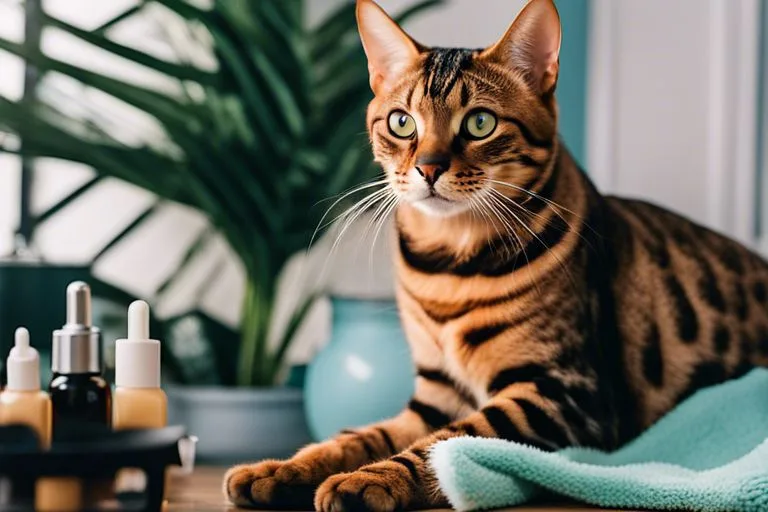Hey there, are you considering bringing a Bengal cat into your home? These stunning and exotic felines are known for their striking coats and energetic personalities. However, you may be wondering if they require extra attention when it comes to shedding and claws. The truth is, Bengal cats are relatively low maintenance when it comes to grooming and shedding. Their short, sleek coats only require a weekly brushing to keep them looking their best. However, their claws can be a different story. Bengals are active and playful cats, which means they need an outlet for their natural scratching behavior. Providing your Bengal with a quality scratching post and regular nail trims will help keep both your furniture and your feline friend safe and happy.
Key Takeaways:
- Bengal cats do require extra attention for shedding and claws: Due to their unique coat and energetic nature, Bengal cats may require regular grooming to manage shedding and help prevent matting. Additionally, their active and playful nature may require regular nail trimming to avoid damage from scratching.
- Regular grooming is essential: Routine brushing of your Bengal cat’s coat can help minimize shedding and reduce the risk of matting. Additionally, keeping their claws trimmed can help prevent damage to furniture and injury to themselves and others.
- Engaging in interactive play and providing scratching posts can help manage shedding and claws: Providing your Bengal cat with appropriate outlets for scratching, such as scratching posts or cat trees, can help redirect their natural behaviors. Additionally, engaging in interactive play sessions can help them expend energy and reduce excessive shedding and scratching.
Shedding in Bengal Cats
While Bengal cats are relatively low maintenance in terms of grooming, they do shed. Their short, luxurious coats require regular brushing to minimize shedding. Brushing not only helps to remove loose hairs, but it also distributes skin oils, resulting in a healthier coat for your cat. Regular brushing can also help reduce the amount of hair your Bengal cat sheds around your home. If you are dealing with excessive shedding, consider trimming your cat’s claws to minimize any damage from excessive scratching and shedding.
Shedding Patterns and Seasons
Bengal cats typically shed year-round, but they may also experience heavier shedding during the change of seasons. During these times, you may notice an increase in fur around your home. This shedding pattern is a natural process for all cats, but it can be intensified in Bengal cats due to their soft, dense, and close-lying coat.
Managing Shedding: Tips and Techniques
To manage shedding in your Bengal cat, it’s essential to regularly brush their coat with a quality grooming brush designed for short-haired breeds. Additionally, providing a proper diet rich in omega-3 fatty acids can help promote healthy skin and coat, minimizing shedding. After brushing, make sure to clean the brush to remove any loose fur, so you’re not inadvertently spreading it around your home.
- Invest in a high-quality grooming brush suitable for short-haired breeds
- Ensure your cat’s diet includes omega-3 fatty acids for a healthy coat
- Regularly clean your cat’s grooming tools to prevent spreading loose fur
Recommended Tools for Shedding Control
When it comes to tools for shedding control, a slicker brush and a de-shedding tool can be highly effective for removing loose hair from your Bengal cat’s coat. The slicker brush can help remove tangles and mats, while the de-shedding tool is designed to reach deep into your cat’s coat to remove loose undercoat hair, resulting in less shedding around your home.
Claw Care for Bengal Cats
Not only do Bengal cats have a beautiful coat that requires regular grooming, but they also need special attention when it comes to their claws. As a Bengal cat owner, it’s important to understand the unique needs of your feline friend to keep them healthy and happy. If you want to learn more about the positive and negative aspects of owning a Bengal cat, you can check out this Pros and Cons of Bengals! : r/bengalcats discussion on Reddit.
The Necessity of Claw Maintenance
Regular claw maintenance is essential for the health and well-being of your Bengal cat. This not only prevents their claws from becoming too long and causing discomfort, but it also reduces the risk of them accidentally injuring you or damaging furniture with their sharp claws. Additionally, keeping your Bengal’s claws in good condition can help prevent them from getting caught in carpet, fabric, and other materials, which can be painful and even lead to infection. It’s an important part of your responsibility as a pet owner to ensure that your Bengal’s claws are properly cared for.
Tools and Techniques for Claw Trimming
When it comes to trimming your Bengal cat’s claws, you’ll need the right tools and techniques to do the job effectively and safely. Invest in a pair of high-quality cat nail trimmers or clippers specifically designed for cats. You should also have styptic powder on hand to stop any bleeding in case you accidentally cut the quick (the live tissue within the claw). If you’re unsure about how to trim your Bengal’s claws, don’t hesitate to consult with a professional groomer or your veterinarian for guidance. It’s important to be confident in your approach and use the correct technique to avoid causing any harm to your furry friend.
Alternatives to Declawing
Declawing is a controversial and often unnecessary procedure that can cause long-term physical and psychological damage to your Bengal cat. Fortunately, there are several alternatives to declawing that you can explore. Providing your Bengal with scratching posts and pads can help redirect their natural scratching behavior and keep their claws in good condition. There are also soft plastic caps available that can be placed over your cat’s claws to prevent them from causing damage. These alternatives are not only safer and more humane but also help maintain your Bengal’s natural behaviors and instincts.
Additional Grooming Needs
Despite their low-maintenance grooming, Bengal cats require some additional care to keep them looking their best and to maintain their overall health. If you have any questions about the grooming needs of Bengal cats, you can find more about them frequent questions about the Bengal cats on this website.
Bathing and Brushing Requirements
When it comes to grooming, Bengal cats do not usually require frequent baths. Their short, waterproof coat is easily manageable and can be kept clean with regular grooming. Brushing your Bengal once or twice a week is usually enough to minimize shedding and keep their coat looking sleek. Additionally, regular brushing can help prevent hairballs, which can be dangerous if ingested by your cat. Strongly consider getting your Bengal used to bathing and brushing from an early age to make these activities more comfortable for you both.
Ear, Eye, and Dental Care
Regular ear cleaning and teeth brushing are important parts of the grooming routine for Bengal cats. You should check the ears for wax and debris and clean them as needed. Your cat’s teeth should also be brushed regularly to prevent dental problems. Keep an eye out for any signs of redness, discharge, or foul odor, as these can indicate an ear or eye infection that needs attention. Paying attention to your Bengal’s ears, eyes, and dental health is crucial for maintaining their overall well-being. By incorporating these tasks into your regular grooming routine, you can ensure that your Bengal stays healthy and happy.
Conclusion
Taking this into account, it is important to recognize that Bengal cats do require extra attention for shedding and claws. Regular grooming and nail trimming are essential to help manage shedding and prevent potential damage from their claws. By dedicating a few minutes each day to grooming and nail care, you can thoroughly address these issues and keep your Bengal cat healthy and happy. Remember, providing your Bengal with the extra attention they need for shedding and claws will ultimately benefit both you and your feline companion in the long run.
FAQ
Q: Do Bengal Cats Require Extra Attention For Shedding And Claws?
A: Yes, Bengal cats require regular grooming and nail trimming to manage shedding and maintain healthy claws. Their unique coat and active lifestyle may require more attention compared to other cat breeds.
Q: How often should I groom my Bengal cat to manage shedding?
A: It is recommended to brush your Bengal cat’s coat at least once a week to help minimize shedding. During shedding season, which typically occurs in the spring and fall, more frequent brushing may be necessary to remove loose hair.
Q: What is the best grooming tool for Bengal cats?
A: A stainless steel comb with narrow teeth or a rubber grooming glove are excellent tools for grooming Bengal cats. These tools can effectively remove loose hair and help prevent matting, which is common in their soft, luxurious coat.
Q: How can I trim my Bengal cat’s nails safely?
A: Trimming your Bengal cat’s nails regularly using cat-specific nail clippers or scissors can help prevent them from becoming too long and causing discomfort or injury. It’s important to be gentle and cautious while trimming the nails, and to only trim the sharp tip without cutting into the quick, which contains blood vessels and nerves.
Q: What are the benefits of regularly grooming and trimming a Bengal cat?
A: Regular grooming and nail maintenance not only helps manage shedding and keep the cat’s coat in good condition, but it also promotes bonding between the cat and its owner. Additionally, it can prevent hairballs, reduce the risk of skin irritation, and minimize the likelihood of scratches from overgrown claws.



